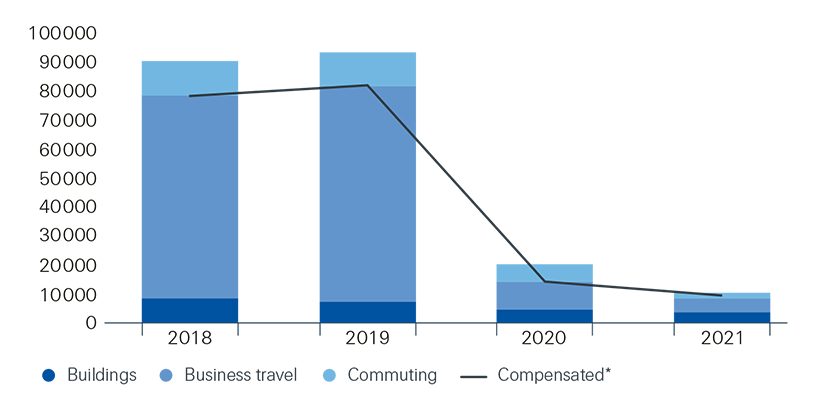- Home
- Sustainability
- Driving sustainable operations
- Our CO2NetZero Programme
- “… remove the rest”: further measures
“… remove the rest”: further measures
Moving from carbon offsetting to carbon removal
Under the new CO2NetZero Programme, funded through our Carbon Steering Levy (see section Introducing our Carbon Steering Levy), we will gradually phase out the purchase of high-quality carbon offsets and, in parallel, increase our support for high-quality carbon removal projects.
In 2021, our total operational emissions were strongly reduced by the impact of the COVID-19-pandemic for a second year in a row, leaving us with a total of 8 400 tonnes of CO₂ₑ to be compensated. This low amount of operational emissions in scope for compensation allowed us to achieve a higher percentage (35%) of carbon removal certificates in our emissions compensation mix, thus overachieving our minimum target of 10%. We sourced these certificates from a variety of suppliers and two project types.
Swiss Re’s operational emissions in current reporting scope, in tonnes CO₂e

All carbon avoidance certificates are of the “displace wood consumption” type and stem from a Gold Standard project in Rwanda where new water boreholes are financed to prevent wood burning for the purpose of purifying drinking water. All carbon removal certificates are of the “biochar” type and stem from various suppliers in Europe and the US (contracted durability = 50 – 100 years).
Biochar results from heating biomass in the absence of oxygen (“pyrolysis”). It consists of carbon black, which decomposes very slowly under natural conditions, rendering biochar a more durable form of carbon storage than the original biomass. It is usually added to degraded topsoil to improve soil fertility.
Partnering with Climeworks
See Focus: Partnering with Climeworks.
Helping to reduce emissions beyond our value chain
Helping others to reduce their emissions was an integral part of our previous Greenhouse Neutral Programme. Since 2003, we have been compensating 100% of our direct emissions (Scope 1), 100% of our indirect emissions (Scope 2) and our business travel emissions (part of upstream Scope 3) by supporting high-quality carbon avoidance projects. Since 2014, we have included further upstream Scope 3 emission categories in our compensation efforts: energy transmission and distribution, paper, water and waste.
Between 2014 and 2020, we helped avoid close to half a million tonnes of CO₂ₑ emissions, purchasing carbon offsets exclusively from Gold Standard projects (see link below for more information).
Purchasing high-quality carbon offsets
Sharing our carbon removal knowledge
Carbon removal is still in its infancy. After providing a high-level overview on the topic in our SONAR 2020 report on emerging risks, Swiss Re Institute released an Expertise Publication entitled “The insurance rationale for carbon removal solutions” in 2021. For more information, see “Engaging in dialogue with our stakeholders” .
Furthermore, the World Economic Forum’s Alliance of CEO Climate Leaders co-chaired by our Group CEO, formed a climate action group on carbon removal in spring 2021. Under Swiss Re’s leadership, the action group contributed to the white paper “Net-Zero to Net-Negative: A Guide for Leaders on Carbon Removal” and produced an educational slide deck from CEOs to CEOs: “On the critical role of carbon removal and how companies can use it smartly”.